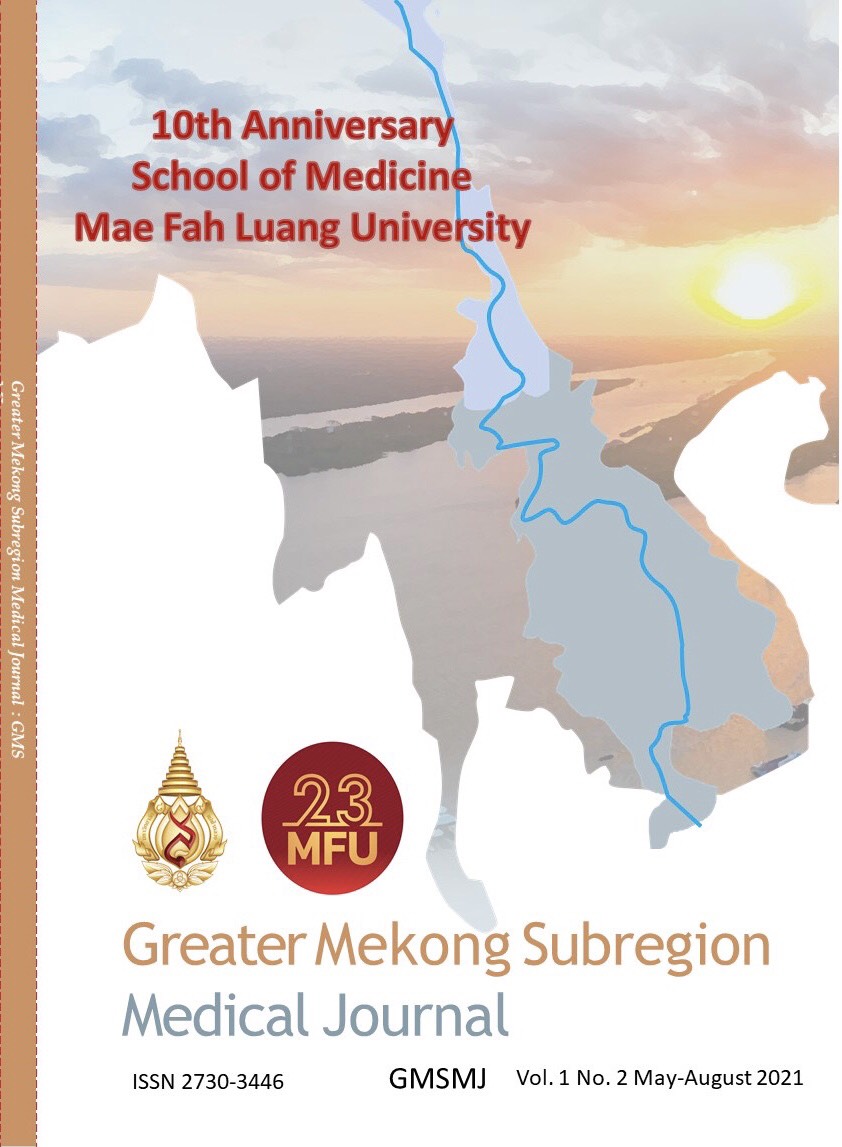The Presence of Monoterpenes in Rhynchanthus longiflorus Hook.f. Confirms the Value of Its Use in Akha Folk Medicine
Keywords:
Akha, Rhynchanthus longiflorus Hook.f., MonoterpeneAbstract
Background: Rhynchanthus longiflorus Hook.f. is an endangered species and is part of the ginger family. A decoction of its rhizomes is mentioned in Akha folk medicine for the treatment of convulsions.
Objective: With no prior studies performed, it was reasonable to analyze the chemical components of the rhizomes responsible for the odor, taste and perhaps medicinal claims for the plant.
Methods: Rhizomes of Rhynchanthus longiflorus Hook.f. were bought from local markets in Chiang Rai, Thailand. They were subjected to hydrodistillation to obtain the essential oil. Analysis of the oil was done by GC-MS.
Results: Fifteen monoterpenes were identified from the essential oil. The most abundant compounds were 1, 8-Cineol (70.705 %), beta-Pinene (7.008%), alpha-Pinene (4.763%) and Sabinene (3.484%) which comprised 85.96 % of the oil. These monoterpenes have been reported to reduce mortality and attenuate seizures in animal models
Conclusion: The essential oil from Rhynchanthus longiflorus Hook.f. rhizomes contains monoterpene compounds whose anticonvulsant effects could be the basis for the use of this plant in Akha folk medicine.
References
Phumthum M, Srithi K, Inta A, Junsongduang A, Tangjitman K, Pongamornkul W, et al. Ethnomedicinal plant diversity in Thailand. J Ethnopharmacol 2018; 214: 90-8.
Panyadee P, Balslev H, Wangpakapattanawong P, Inta A. Medicinal plants in homegardens of four ethnic groups in Thailand. J Ethnopharmacol 2019; 239: 111927.
Prasanthkumar MG , Leong - Skornickova J, Mamiyil S, Jayasree S. Conservation priority and phytogeographical significance of Rhynchanthus longiflorus Hook. f. (Zingiberaceae): A rare, endangered species from Mizo Hills, NE India. Current science 2005; 88: 977-80.
Prachaya Srisanga SW, Wasana Kamkuan, Trai Pekthong, Jantrararuk Tovaranonte, Nontachaiyapoom TYS. Ethnobotany of Akha in Huay Yuak Pa So village, Mae Fah Luang district and Ban Mai Patthana village, Mae Suai district, Chiang Rai province. Thai Journal of Botany 2011. p. 93-114.
Engel J. Surgery for Seizures. New England Journal of Medicine. 1996; 334 (10): 647-53.
Larsen K, Lock, J. M., Mass H. and Mass PJM. The Families and Genera of Vascular Plants (ed. Kubitzki, K.). Springer-Verlag, Berlin; 1998. p. 474-95.
Lewis PW. Peoples of the Golden Triangle: six tribes in Thailand / Paul and Elaine Lewis. Lewis E, editor. London: Thames and Hudson; 1984.
Oliveira J, Porto L, Estevam C, Siqueira R, Alves P, Dos Santos Niculau E, et al. Phytochemical screening and anticonvulsant property of Ocimum basilicum leaf essential oil. Boletín Latinoamericano y del Caribede Plantas Medicinales y Aromáticas 2009; 8.
Masoumi-Ardakani Y, Mandegary A, Esmaeilpour K, Najafipour H, Sharififar F, Pakravanan M, et al. Chemical Composition, Anticonvulsant Activity, and Toxicity of Essential Oil and Methanolic Extract of Elettaria cardamomum. Planta Med. 2016; 82 (17): 1482-6.
Bakkali F, Averbeck S, Averbeck D, Idaomar M. Biological effects of essential oils--a review. Food Chem Toxicol. 2008; 46 (2): 446-75.
Pardridge WM. Drug transport across the blood-brain barrier. J Cereb Blood Flow Metab 2012; 32 (11): 1959-72.
Quintans JSS, Shanmugam S, Heimfarth L, Araújo AAS, Almeida J, Picot L, et al. Monoterpenes modulating cytokines - A review. Food Chem Toxicol 2019; 123: 233-57.
Quiroga PR, Asensio CM, Nepote V. Antioxidant effects of the monoterpenes carvacrol, thymol and sabinene hydrate on chemical and sensory stability of roasted sunflower seeds. J Sci Food Agric 2015; 95 (3): 471-9.
Grassmann J. Terpenoids as plant antioxidants. Vitam Horm 2005; 72: 505-35.
Marchi N, Granata T, Janigro D. Inflammatory pathways of seizure disorders. Trends Neurosci 2014; 37 (2): 55-65.
Munguía-Martínez MF, Nava-Ruíz C, Ruíz-Díaz A, Díaz-Ruíz A, YescasGómez P, Méndez-Armenta M. Immunohistochemical Study of Antioxidant Enzymes Regulated by Nrf2 in the Models of Epileptic Seizures (KA and PTZ). Oxidative Medicine and Cellular Longevity 2019; 1327986.
Rana A, Musto AE. The role of inflammation in the development of epilepsy. Journal of neuroinflammation 2018; 15 (1): 144-55.
Sobreira Dantas Nóbrega de Figuêiredo FR, Monteiro Á B, Alencar de Menezes IR, Sales VDS, Petícia do Nascimento E, Kelly de Souza Rodrigues C, et al. Effects of the Hyptis martiusii Benth. leaf essential oil and 1,8-cineole (eucalyptol) on the central nervous system of mice. Food Chem Toxicol 2019; 133: 110802.
Ueno H, Shimada A, Suemitsu S, Murakami S, Kitamura N, Wani K, et al. Alpha-pinene and dizocilpine (MK-801) attenuate kindling development and astrocytosis in an experimental mouse model of epilepsy. IBRO Rep 2020; 9: 102-14.
Felipe CFB, Albuquerque AMS, de Pontes JLX, de Melo JÍ V, Rodrigues T, de Sousa AMP, et al. Comparative study of alpha- and beta-pinene effect on PTZ-induced convulsions in mice. Fundam Clin Pharmacol 2019; 33 (2): 181-90.
de Sousa DP, Quintans L, de Almeida RN. Evolution of the Anticonvulsant Activity of α-Terpineol. Pharmaceutical Biology 2007; 45 (1): 69-70.
Elisabetsky E, Brum LF, Souza DO. Anticonvulsant properties of linalool in glutamate-related seizure models. Phytomedicine 1999; 6 (2): 107-13.
Viana GS, do Vale TG, Silva CM, Matos FJ. Anticonvulsant activity of essential oils and active principles from chemotypes of Lippia alba (Mill.) N.E. Brown. Biol Pharm Bull 2000; 23 (11): 1314-7.
Wahab A, Ul Haq R, Ahmed A, Khan RA, Raza M. Anticonvulsant activities of nutmeg oil of Myristica fragrans. Phytother Res 2009; 23 (2): 153-8.






